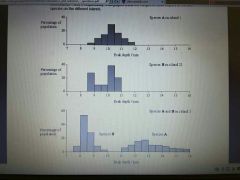![]()
![]()
![]()
Use LEFT and RIGHT arrow keys to navigate between flashcards;
Use UP and DOWN arrow keys to flip the card;
H to show hint;
A reads text to speech;
17 Cards in this Set
- Front
- Back
|
Why aren't all alleles equally likely to be passed on? |
Some organisms may have characteristics that improve their chances of survival |
|
|
What can affect the allelic frequency? |
Success of reproduction of individuals |
|
|
Describe the process of natural selection |
All organisms produce more offspring that can be supported by resources such as food and space etc Even though there's loads of offspring populations can stay the same Intraspecific competition between organisms of the same species to survive There is a gene pool within this species Some will have certain alleles that can help them survive Those that have these alleles are more likely to produce more offspring So alleles with the most competitive advantage are most likely to be passed on Over a long period of time those organisms that have the advantageous allele will increase |
|
|
What makes an allele advantageous? |
Depends upon environmental conditions |
|
|
What are the 3 different types of selection? |
Directional, stabilising and disruptive |
|
|
When does directional selection occur? |
There has been a change in the environmental conditions |
|
|
When does stabilising selection occur? |
Environmental conditions have remained the same |
|
|
What type of selection favours certain individuals that vary in one direction of the mean? |
Directional |
|
|
What type of selection favours average individuals closer to the mean? |
Stabilising |
|
|
Lake Malawi in East Africa contains around 400 different species of cichlids which are small, brightly coloured fish. All these species have evolved from a common ancestor. Describe one way in which scientists could find out whether cichlids from two different populations belong to the same species |
See if they can interbreed and produce fertile offspring if they can then same species |
|
|
In a investigation, the tolerance to copper ions of the grass Agrostia tenuis was determined. Samples were taken of plants growing in waste from a copper mine and from nearby areas just outside the mine. The mean copper tolerance of plants from the mine waste was found to be four times higher than that of plants in the surrounding area. Explain how natural selection could produce a copper -tolerant population in the mine waste |
Variation present in original population Copper tolerant individuals more likely to survive There reproduce and pass on genes to next generation/offspring Increase in frequency of copper tolerance alleles |
|
|
Explain how emigration / immigration is important in maintaining genetic variability in lemmings populations which have large fluctuations in size |
Smaller populations have fewer different alleles Smaller gene pool Migrants bring in new alleles and increase gene pool |
|
|
A large ocean bay in Northern Canada was formed by melting of glaciers. One species of lemmings inhabits the eastern side and other species of lemming inhabits the western side. Before the glaciers melted there was only one species of lemming present . Explain how two species of lemming evolved from the original species |
Geographical isolation of populations Variations present in populations Different environmental conditions Different selection pressures Change in allele Frequency and gene pool Two populations so unable to interbreed to produce fertile offspring |
|

What type of natural selection took place of both species after they had colonised island 3? Explain your answer (3) |
Directional selection Selection for one extreme Whole distribution is shifted towards favoured extreme |
|
|
Some antibiotics bind with specific receptors in the plasma membranes of bacteria. The structure of these receptors is determined genetically. Bacteria can become resident to an antibiotic because a gene mutation results in altered receptor. Explain how resistance to an antibiotic could become widespread in a bacterial population following a gene mutation conferring resistance in just one bacterium. |
Frequent use of antibiotics creates selection pressure as antibiotic kills bacteria Bacteria with mutation have selective advantage over others They survive and reproduce other types Pass on advantageous allele Frequency you of advantageous allele increases in next generations Frequency of resistant types increase in next generations |
|
|
Define selection |
Process by which organisms what are better adapted to their environment survive and breed, while those less well adapted fail to do so |
|
|
Describe the difference between stabilising and directional selection |
Stabilising - individuals with alleles for a characteristic towards the middle of the range are more likely to survive, reproduce and pass on their alleles Directional - individuals with alleles for a characteristics at the extreme end of the range are more likely to survive, reproduce and pass on their alleles |

